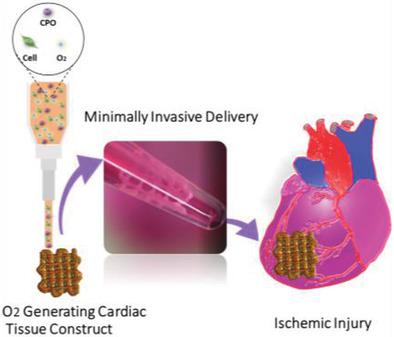当前位置:
X-MOL 学术
›
Adv. Healthcare Mater.
›
论文详情
Our official English website, www.x-mol.net, welcomes your
feedback! (Note: you will need to create a separate account there.)
3D Bioprinting of Oxygenated Cell-Laden Gelatin Methacryloyl Constructs.
Advanced Healthcare Materials ( IF 10.0 ) Pub Date : 2020-06-16 , DOI: 10.1002/adhm.201901794 Ahmet Erdem 1, 2, 3, 4 , Mohammad Ali Darabi 1, 2, 5 , Rohollah Nasiri 1, 2, 6 , Sivakoti Sangabathuni 1, 2 , Yavuz Nuri Ertas 2, 7, 8 , Halima Alem 1, 2, 9 , Vahid Hosseini 1, 2, 5 , Amir Shamloo 6 , Ali S Nasr 10 , Samad Ahadian 1, 2, 5 , Mehmet R Dokmeci 1, 2, 5, 11 , Ali Khademhosseini 1, 2, 5, 11, 12 , Nureddin Ashammakhi 1, 2, 11
Advanced Healthcare Materials ( IF 10.0 ) Pub Date : 2020-06-16 , DOI: 10.1002/adhm.201901794 Ahmet Erdem 1, 2, 3, 4 , Mohammad Ali Darabi 1, 2, 5 , Rohollah Nasiri 1, 2, 6 , Sivakoti Sangabathuni 1, 2 , Yavuz Nuri Ertas 2, 7, 8 , Halima Alem 1, 2, 9 , Vahid Hosseini 1, 2, 5 , Amir Shamloo 6 , Ali S Nasr 10 , Samad Ahadian 1, 2, 5 , Mehmet R Dokmeci 1, 2, 5, 11 , Ali Khademhosseini 1, 2, 5, 11, 12 , Nureddin Ashammakhi 1, 2, 11
Affiliation

|
Cell survival during the early stages of transplantation and before new blood vessels formation is a major challenge in translational applications of 3D bioprinted tissues. Supplementing oxygen (O2) to transplanted cells via an O2 generating source such as calcium peroxide (CPO) is an attractive approach to ensure cell viability. Calcium peroxide also produces calcium hydroxide that reduces the viscosity of bioinks, which is a limiting factor for bioprinting. Therefore, adapting this solution into 3D bioprinting is of significant importance. In this study, a gelatin methacryloyl (GelMA) bioink that is optimized in terms of pH and viscosity is developed. The improved rheological properties lead to the production of a robust bioink suitable for 3D bioprinting and controlled O2 release. In addition, O2 release, bioprinting conditions, and mechanical performance of hydrogels having different CPO concentrations are characterized. As a proof of concept study, fibroblasts and cardiomyocytes are bioprinted using CPO containing GelMA bioink. Viability and metabolic activity of printed cells are checked after 7 days of culture under hypoxic condition. The results show that the addition of CPO improves the metabolic activity and viability of cells in bioprinted constructs under hypoxic condition.
中文翻译:

含氧细胞明胶甲基丙烯酰结构的 3D 生物打印。
移植早期阶段和新血管形成之前的细胞存活是 3D 生物打印组织转化应用的主要挑战。通过过氧化钙 (CPO) 等 O 2生成源向移植细胞补充氧气 (O 2 ) 是确保细胞活力的一种有吸引力的方法。过氧化钙还会产生氢氧化钙,降低生物墨水的粘度,这是生物打印的限制因素。因此,将该解决方案应用于3D生物打印具有重要意义。在这项研究中,开发了一种在 pH 值和粘度方面进行优化的明胶甲基丙烯酰 (GelMA) 生物墨水。改进的流变特性可生产出适合 3D 生物打印和受控 O 2释放的坚固生物墨水。此外,还表征了具有不同CPO浓度的水凝胶的O 2释放、生物打印条件和机械性能。作为概念验证研究,使用含有 GelMA 生物墨水的 CPO 对成纤维细胞和心肌细胞进行生物打印。在缺氧条件下培养 7 天后检查打印细胞的活力和代谢活性。结果表明,CPO 的添加提高了生物打印结构中细胞在缺氧条件下的代谢活性和活力。
更新日期:2020-08-05
中文翻译:

含氧细胞明胶甲基丙烯酰结构的 3D 生物打印。
移植早期阶段和新血管形成之前的细胞存活是 3D 生物打印组织转化应用的主要挑战。通过过氧化钙 (CPO) 等 O 2生成源向移植细胞补充氧气 (O 2 ) 是确保细胞活力的一种有吸引力的方法。过氧化钙还会产生氢氧化钙,降低生物墨水的粘度,这是生物打印的限制因素。因此,将该解决方案应用于3D生物打印具有重要意义。在这项研究中,开发了一种在 pH 值和粘度方面进行优化的明胶甲基丙烯酰 (GelMA) 生物墨水。改进的流变特性可生产出适合 3D 生物打印和受控 O 2释放的坚固生物墨水。此外,还表征了具有不同CPO浓度的水凝胶的O 2释放、生物打印条件和机械性能。作为概念验证研究,使用含有 GelMA 生物墨水的 CPO 对成纤维细胞和心肌细胞进行生物打印。在缺氧条件下培养 7 天后检查打印细胞的活力和代谢活性。结果表明,CPO 的添加提高了生物打印结构中细胞在缺氧条件下的代谢活性和活力。











































 京公网安备 11010802027423号
京公网安备 11010802027423号